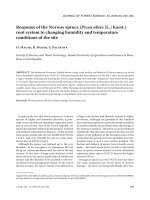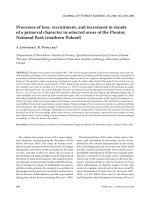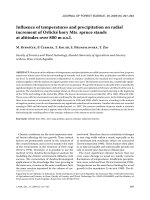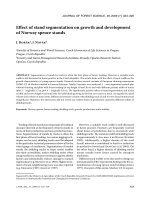Báo cáo lâm nghiệp: "Responses of photosynthesis and stomatal conductance to atmospheric humidity in some mediterranean Abies specie" ppt
Bạn đang xem bản rút gọn của tài liệu. Xem và tải ngay bản đầy đủ của tài liệu tại đây (179.1 KB, 5 trang )
Responses
of
photosynthesis
and
stomatal
conductance
to
atmospheric
humidity
in
some
mediterranean
Abies
species
J.M.
Guehi
1
J.
Bouachrine’
R.
Zimmermann
2
E.
Dreyer
1
! Laboratoire
de
Bioclimatologie-Ecophysiologie
Forestiere,
Station
de
Sylviculture
et
Production,
INRA,
Centre
de
Nancy,
F-54280
Seichamps,
France,
and
2
Lehrstuhl
fOr
Pfanzenökologie,
Universität
Bayreuth,
Postfach
3008, D-8580
Bayreuth,
F.R.G.
Introduction
Leaf
gas-exchange
has
long
been
shown
to
be
sensitive
to
changes
in
the
water
vapor
mole
fraction
difference
between
the
leaf
and
the
air
(Aw )
(Sandford
and
Jar-
vis,
1986;
Schulze,
1986).
It
has
been
pro-
posed
(Guehl
and
Aussenac,
1987;
Grieu
et
al.,
1988)
that
decreasing
C0
2
assimila-
tion
in
response
to
increasing
Aw
is
not
only
due
to
stomatal
closure,
but
could
be,
at
least
partially,
a
consequence
of
altered
mesophyll
photosynthetic
capacity.
How-
ever,
that
interpretation
is
not
consensual
(Terashima
et al.,
1988).
We
report
herein
results
providing
further
evidence
for
the
existence
of
a
mesophyll
effect
in
re-
sponse
to
increasing
Aw
in
some
mediter-
ranean
Abies
species.
The
study
was
also
aimed
at
determining
whether
the
different
species
examined
exhibit
differences
in
their
water
use
efficiencies.
Materials
and
Methods
Responses
of
C0
2
assimilation
rate
(A)
and
transpiration
rate
(E)
to
varying
dw
were
as-
sessed
under
controlled
environmental
condi-
tions
with
an
open
gas-exchange
measurement
system
on
intact
or
excised
shoots
of
different
mediterranean
coniferous
species.
Stomatal
conductance
(g!
and
intercellular
C0
2
concen-
tration
(Ci)
were
calculated
from
the
gas-
exchange
data
using
classical
equations
(see
Guehl
and
Aussenac,
1987).
Prior
to
dw
being
increased,
the
short-term
response
of
gas-
exchange
to
increasing
ambient
C0
2
concen-
tration
(C
a)
was
assessed,
and
the
corre-
sponding
A(Ci)
functions
were
determined,
thus
allowing
the
analysis
of
C0
2
assimilation
in
terms
of
mesophyll
photosynthetic
capacity
(demand
function,
see
Fig.
1)
and
diffusional
limitation
of
C0
2
supply
to
the
chloroplasts
(supply
function).
The
A(CiJ
functions
were
also
used
to
determine
the
marginal
water
cost
of
C0
2
assimilation
(DEJDA)
(Guehl
and
Aussenac,
1987)
and
to
examine
the
gas-exchange
regu-
lation
with
respect
to
the
optimization
theory
of
Cowan
and
Farquhar
(1977).
Results
and
Discussion
Increasing
Aw
resulted
in
markedly
low-
ered
A
(Fig.
1 a)
and
gs
(Fig.
1 b)
in
seed-
lings
of
Abies
nordmanniana.
Stomatal
closure
was
efficient
enough
for
the
E
(dw)
response
to
exhibit
a
maximum
at
Aw = 12
Pa-kPa-
1
(Fig.
1c),
thus
supporting
the
postulate
(Schulze,
1986)
that
alterations
of
leaf
water
status
are
not
involved
in
the
responses
of
A
and
gs
to
Aw
Analyzing
the
data
in
an
A
vs
Ci graph
(Fig.
1d,
closed
symbols)
showed,
as
had
already
been
found
for
other
coniferous
species
(Guehl
and
Aussenac,
1987;
Grieu
et
aL,
1988),
that
the
experimental
points
did
not
remain
on
the
initial
demand
function.
That
such
a
reponse
pattern
actually
denotes
an
effect
of
3w
on
the
mesophyll
photosynthetic
capacity,
and
is
not
an
artifact
due
to
improper
Ci
calcula-
tion
(Terashima
et
al.,
1988),
was
shown
in
the
second
phase
of
the
experiment
in
which
Aw
was
returned
near
its
initial
low
level.
During
that
phase,
A
recovered
par-
tially,
with
the
data
points
remaining
approximately
on
the
same
supply
func-
tion
(Fig.
1d,
open
symbols),
thus
indi-
cating
that
the
recovery
of
A
was
almost
fully
accounted
for
by
a
recovery
of
meso-
phyll
photosynthesis.
Fig.
2
gives
a
further
example
of
uncoupling
between
diffusional
and
mesophyll
photosynthetic
processes
in
response
to
increasing
Aw:
Pinus
pinea
seedlings,
having
a
leaf
diffusional
struc-
ture
not
fundamentally
different
from
that
of
the
Abies
exhibited
a
pure
stomatal
re-
sponse
(constant
D
function)
of
A
to
dw
between
10.0
and
22.0
Pa-kPa-!.
Significant
differences
in
the
gas-
exchange
response
to
dw
(Fig.
3)
were
found
in
a
comparative
study
on
4
Abies
species
originating
from
different
high
ele-
vation
regions
of
the
Mediterranean
area.
A.
cephalonica,
and
A.
marocana
had
the
highest
A
values
for
a
given
Aw.
These
2
species
had
!also
the
lowest
EZ4
and
818A
ratios
(Fig.
4)
and,
furthermore,
818A
was
constant
with
Aw,
which
indi-
cates
optimization
between
C0
2
assimila-
tion
and
transpirational
water
losses
(Cowan
and
Farquhar,
1977).
In
A.
nord-
manniana
and
A.
alba,
E/A
and
818A
were
higher
and
optimization
was
not
achieved.
These
results
are
in
good
agreement
with
the
growth
performances
of
the
studied
species
in
southern
France.
References
Cowan
I.R.
&
Farquhar
G.D.
(1977)
Stomatal
function
in
relation
to
leaf
metabolism
and
envi-
ronment.
Symp.
Soc.
Exp.
Biol.
31,
471-505
Grieu
P.,
Guehl
J.M.
&
Aussenac
G.
(1988)
The
effects
of
soil
and
atmospheric
drought
on
pho-
tosynthesis
and
stomatal
control
of
gas
ex-
change
in
three
coniferous
species.
Physiol.
Plant.
73,
97-104
Guehl
J.M.
&
Aussenac
G.
(1987)
Photosynthe-
sis
decrease
and
stomatal
control
of
gas
exchange
in
Abies
alba
Mill.
in
response
to
vapor
pressure
difference.
Plant
Physiol.
83,
316-322
Sandford
A.P.
&
Jarvis
P.G.
(1986)
Stomatal
responses
to
humidity
in
selected
conifers.
Tree
Physiol.
2,
89-103
Schulze
E.D.
(1986)
Carbon
dioxide
and
water
vapor
exchange
in
response
to
drought
in
the
atmosphere
and
in
the
soil.
Annu.
Rev.
Plant
Physiol.
37,
247-274
Terashima
I.,
Wong
S.C.,
Osmond
C.B.
&
Far-
quhar
G.D.
(1988)
Characterization
of
non-uni-
form
photosynthesis
induced
by
abscisic acid
in
leaves
having
different
mesophyll
anatomies.
Plant
Cell
Physiol.
29,
385-394









